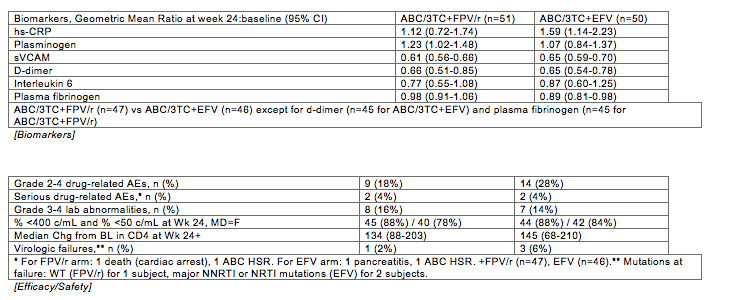 |
 |
 |
| |
Abacavir/lamivudine (ABC/3TC) with fosamprenavir/ritonavir (FPV/r) or efavirenz (EFV) in underrepresented, antiretroviral (ARV) naïve, HIV-infected subjects (SUPPORT): tolerability, safety, and efficacy after 24 weeks
|
| |
| |
Vienna 2010 !AC
Presented by P Kumar (United States).
P. Kumar1, E. DeJesus2, G. Huhn3, L. Sloan4, F. Garcia5, C. Small6, H. Edelstein7, F. Felizarta8, R. Hao9, K. Oie10, L. Ross10, B. Stancil10, B. Ha10, K. Pappa10, SUPPORT Study Team
1Georgetown University, Washington, United States, 2Orlando Immunology Ctr, Orlando, United States, 3Ruth M. Rothstein CORE Center, Chicago, United States, 4North Texas Infectious Disease Consultants, Dallas, United States, 5Valley AIDS Council, Harlingen, United States, 6New York Medical College, Valhalla, United States, 7Alameda County Medical Center, Oakland, United States, 8TBD, Bakersfield, United States, 9Chase Brexton Health Services, Inc., Baltimore, United States, 10GlaxoSmithKline, RTP, United States
the virologic suppression in the early weeks after starting therapy is quicker in the EFV arm than the FPV/r arm.
Background: People of color have been largely underrepresented in clinical trials of ARVs in HIV. In this 96-week, open-label, prospective, randomized, multicenter study, we compared once-daily ABC/3TC 600mg/300mg taken with FPV 1400mg/r100 mg or EFV 600mg in underrepresented ART-naïve subjects.
Methods: Randomization was stratified by screening RNA (< vs ≥105 c/mL). Subjects were excluded if they were HLA-B*5701 positive or had EFV or FPV resistance mutations. Primary endpoint was time to switch of third drug or time to development of any treatment-related Grade 3-4 AEs. Change from baseline in 6 cardiovascular biomarkers was assessed at this planned week 24 analysis.
Results: SUPPORT enrolled 32% (32/101) women and 79% (79/101) people of color. 93 (92%) completed study through 24 weeks. Treatments were comparable in primary endpoint (3 events each), biomarkers, and efficacy.

Conclusions: In this predominantly minority population, comparisons of tolerability/safety, inflammatory biomarkers, and virologic/immunologic responses were not demonstrably different between treatments through 24 weeks.
|
| |
|
 |
 |
|
|